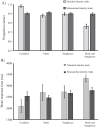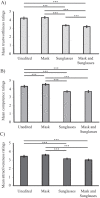Face masks versus sunglasses: limited effects of time and individual differences in the ability to judge facial identity and social traits
- PMID: 35171394
- PMCID: PMC8850515
- DOI: 10.1186/s41235-022-00371-z
Face masks versus sunglasses: limited effects of time and individual differences in the ability to judge facial identity and social traits
Abstract
Some research indicates that face masks impair identification and other judgements such as trustworthiness. However, it is unclear whether those effects have abated over time as individuals adjust to widespread use of masks, or whether performance is related to individual differences in face recognition ability. This study examined the effect of masks and sunglasses on face matching and social judgements (trustworthiness, competence, attractiveness). In Experiment 1, 135 participants across three different time points (June 2020-July 2021) viewed unedited faces and faces with masks, sunglasses, or both. Both masks and sunglasses similarly decreased matching performance. The effect of masks on social judgements varied depending on the judgement and whether the face was depicted with sunglasses. There was no effect of timepoint on any measure, suggesting that the effects of masks have not diminished. In Experiment 2, 12 individuals with developmental prosopagnosia (DP) and 10 super-recognisers (SRs) completed the same tasks. The effect of masks on identity matching was reduced in SRs, whereas the effects of masks and sunglasses for the DP group did not differ from controls. These findings indicate that face masks significantly affect face perception, depending on the availability of other facial information, and are not modified by exposure.
Keywords: Face coverings; Face recognition; Prosopagnosia; Super recognisers; Trait judgements.
© 2022. The Author(s).
Conflict of interest statement
The authors declare that they have no competing interests.
Figures








References
Publication types
MeSH terms
LinkOut - more resources
Full Text Sources
